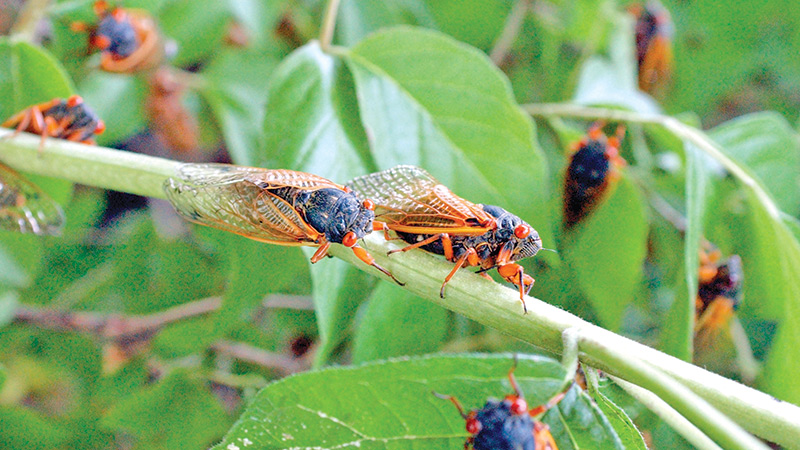Pesky sights, sounds of ‘really odd’ cicadas return to Valley

By Justin Dennis
jdennis@vindy.com
Mahoning Valley residents will soon witness a once-in-a-generation natural phenomenon.
Actually, they’ll probably hear it first.
Now that the last of winter’s chill is receding from the ground, under spring sun and warm rains, millions of cicadas that have spent the last 17 years underfoot have begun working their way to the surface to breed, then die.
This particular brood of cicada native to our region – dubbed Brood VIII by scientists – spends almost all of its 17-year life cycle underground, feeding on roots of trees and shrubs.
When they surface, their mating songs will be deafening, said Eric Barrett, director of the Ohio State University extension office in Canfield.
“We’re actually going to see one-on-one nature, and this really odd thing that stays in the ground and feeds on roots for 17 years then comes out,” he said. “It’s an unusual event you’re not going to see more than a couple times in your lifetime.”
He estimates the vacationers could arrive this week or next, once the ground temperature warms to 65 degrees. On Friday, the ground temperature at the OSU’s closest weather station in Wooster reached nearly 61 degrees.
Those who have studied past emergences in the area expect the most cicadas to burrow from the ground in Wick Park in Youngstown, Austintown Township Park and near Immaculate Heart of Mary Parish in Austintown.
The periodic cicadas don’t eat much once they surface, nor do they bite or sting, so there’s no need for any form of chemical control, Barrett said. They’ll be gone after a few weeks, anyway, often leaving behind molted husks after the ground dwellers emerge as flying insects to mate.
Female cicadas tend to deposit eggs inside twigs or stems that are about pencil-size, however, so Barrett recommended owners of newly planted shrubs or trees cover them with cheesecloth or fine netting to avoid any damage.
The bugs aren’t found anywhere past the Rocky Mountains – only as far as parts of eastern Kansas and Nebraska and northern Michigan. They’re just as unique to this part of the world as giraffes are to Africa, said Gene Kritsky, the dean of behavioral and natural sciences at Mount St. Joseph University in Cincinnati.
To Kritsky, the periodical cicadas are “bugs of history” in that they appear only a few times throughout one’s lifespan, making colorful memories he’s curated over more than 40 years of studying the puzzling critters.
“If anyone remembers them as a kid … they’ll remember what they were doing back in those days,” he said.
During a 1987 emergence elsewhere in the country, one woman “distinctly remembered” the first time she saw the cicadas in 1936, Kritsky said.
“One landed on her brother’s face. She decided to knock it off with a baseball bat,” he said with a laugh.
That woman told that same story to her daughter at the next emergence, then later to her granddaughter, Kritsky said.
It’s Ray Novotny’s third emergence. The Mill Creek MetroParks naturalist and Mahoning Valley Audubon Society chairman said he was “just a kid” when he first saw the 17-year cicadas in 1968. He missed the second in 1985 while he was a graduate student in Columbus. In 2002, he said he was “more ready for it” and enjoyed discovering the cicadas’ hot spot in Wick Park.
This year, the society is bringing Kritsky back for a lecture on periodical cicadas.
“Seventeen years ago was the last time I visited your area and talked about cicadas. It’s only appropriate I come back,” Kritsky said.
Kritsky’s free, one-hour lecture “Periodical Cicadas: The Plague and the Puzzle” is set for 11 a.m. to noon June 8 at the Austintown Senior Center, 112 Westchester Drive. Attendees are invited to then drive to a yet-to-be-determined location for a nature walk. The event is recommended for those age 10 and older.
For information, call Wild Birds Unlimited at 330-629-2473.
Mill Creek MetroParks will also host its own free program with a local entomologist. The program is set for 6 to 7:30 p.m. May 28 at the MetroParks Farm, 7574 Columbiana-Canfield Road, Canfield. To register, call 330-533-5538.
Kritsky said biologists believe the cicadas evolved into their unusually long larval cycle as they adapted to life in the Ice Age.
“When they emerge, they emerge in such numbers that all the birds that eat such insects – and all the raccoons and cats and dogs and mice – can eat their fill and there are still millions left,” he said. “They basically overwhelm their opportunistic predators, and that’s how they survive.”
The cicadas you’ll hear are the males, Kritsky said. They pull muscles attached to structures called “tymbals” just behind their wings. Their mostly hollow abdomens amplify the high-pitched screech, he said.
When the female chooses her mate, she’ll signal with a flick of her wings, he said.
Sometimes, hundreds of cicadas will latch to one particular tree, which becomes their “chorusing center.”
Kritsky said cicada researchers have emergence records dating back to 1934, but they’re still discovering new populations of cicadas. By careful mapping and studying emergence patterns, they were able to verify a whole new southern Ohio brood in 2013, he said.
A free phone app called “Cicada Safari,” recently released for iPhone and Android by Mount St. Joseph University, aims to help scientists map their habitats.
“This is a citizen science project. If they see cicadas in their yard, they literally photograph the cicadas and submit the photo,” Kritsky said.
“I’m asking and hoping the people in Mahoning County will help us increase our understanding of where these cicadas are,” Kritsky said.
“It’s going to be much more well-documented this time,” said Novotny, adding he’s excited to be “witnessing the rare event. I hope not for the last time.”
 43
43
